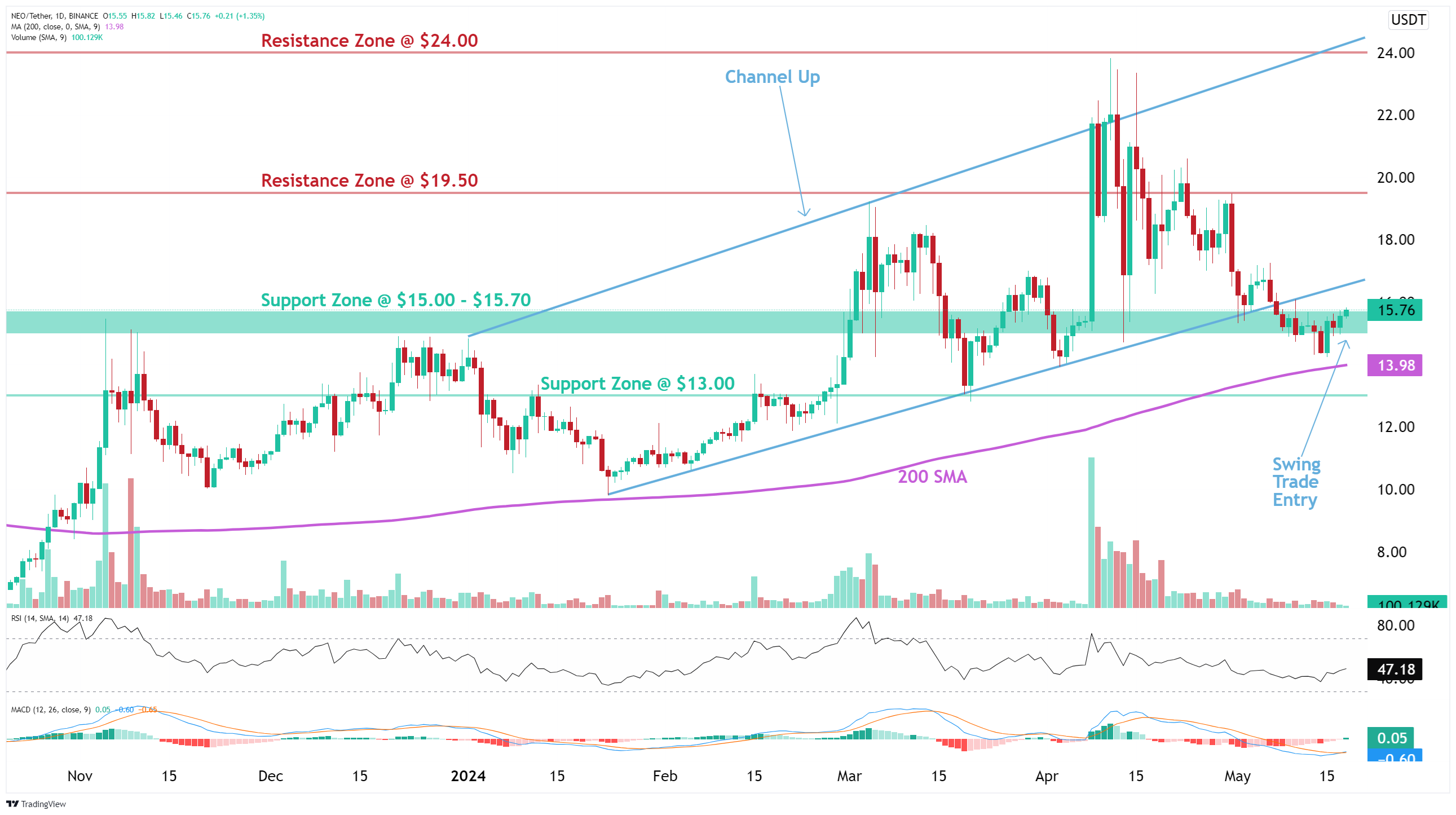NEO (NEO) Analysis
NEO (NEO) Analysis
In addition to automated chart patterns, altFINS’ analysts conduct technical chart analyses of top 30 cryptocurrencies. We call these Curated Charts and they evaluate 5 core principals of technical analysis: Trend, Momentum, Patterns, Volume, Support and Resistance.
NEO (NEO) technical analysis:
Trade setup: Trends are mixed. Price is trading in a Channel Up pattern and is inside a $15.00-$15.70 support zone, which could be a swing trade entry with +25% potential upside to $19.50. Stop Loss (SL) level at $13.60. (set a price alert)
Pattern: Price is trading in a Channel Up pattern. With emerging patterns, traders who believe the price is likely to remain within its channel can initiate trades when the price fluctuates within its channel trendlines. With complete patterns (i.e. a breakout) – initiate a trade when the price breaks through the channel’s trendlines, either on the upper or lower side. When this happens, the price can move rapidly in the direction of that breakout. Learn to trade chart patterns in Lesson 8.
Trend: Downtrend on Short- and Medium-Term basis and Uptrend on Long-Term basis.
Momentum is Mixed as MACD Line is above MACD Signal Line (Bullish) but RSI ~ 50 (Neutral).
Support and Resistance: Nearest Support Zone is $15.00 – $15.70, then $13.00. The nearest Resistance Zone is $19.50, then $24.00.
See more curated charts of coins with technical analyses.
Recent news and research:
EOS community halts payments worth $250 million in EOS to Block.one and Brock Pierce
Neo (NEO) To Re-Shape Governance in N3 Version, Here’s How.
Find more real-time news here.
What is NEO (NEO)?
Find full description and news on altFINS platform.
Overview
NEO aims to build a comprehensive “smart economy” by incorporating digital assets, digital identities, and smart contracts.
History
NEO, originally named Antshares and sometimes called the “Chinese Ethereum”, is China’s first open-source blockchain platform developed to facilitate the easy construction of a digital economy complete with digital identities, assets, contracts, and payments. Founders Da Hongfei and Erik Zhang aim to offer a more-easily scalable, versatile platform that supports a panoply of programming languages, which are compiled in a secure executable environment called NEO Virtual Machine (NeoVM). It aims to compete with Ethereum and other projects that position themselves as developer-friendly decentralized protocols to launch a strong foundation for a future digitized “smart” economy. It also aims to implement features like quantum-computing resistance and inter-chain operability for the most competitive a distributed “smart economy” network.
Technology
NEO’s virtual machine code compiler is designed to support a sizable list of languages including: C#, Java, C, C++, GO, JavaScript, Python, and Ruby. NeoVM is a lightweight, general-purpose virtual machine that is intended to support small programs (e.g. smart contracts) or can be ported into non-blockchain systems. NEO’s goals of cross-chain interchangeability features come from NeoX, a protocol that supports cross-chain asset exchange and distributed transactions, which is to say it aims for consistency and executability of transactions across multiple protocols. For its consensus mechanism, it relies on delegated Byzantine Fault Tolerance (dBFT), which can support up to 10,000 transactions per second. Validating nodes are randomly selected to confirm on-chain transactions by a collective of book-keeping nodes, which mimics the consensus mechanism of protocols like Stellar in some ways. Chain hard forks are more more complicated under dBFT consensus than Proof of Work (PoW), for example. Users cannot fork the chain at will like under PoW consensus since dBFT requires a two-thirds user majority to operate. It also supports two native tokens: NEO and NeoGas (GAS). NEO is a payments token that also confers governance rights over the network’s changes and development. GAS is a fuel token for the NEO virtual machine useful for executing smart contracts and supporting applications built on it.
Supply Curve Details
NEO’s outstanding supply is fixed. The liquid supply increase displayed on the curve is the consequence of the vesting schedules detailed in the Launch section. Validators are incentivized through rewards in NEO GAS, NEO’s secondary token.
Asset profile is provided by messari. Original version can be found at Messari
